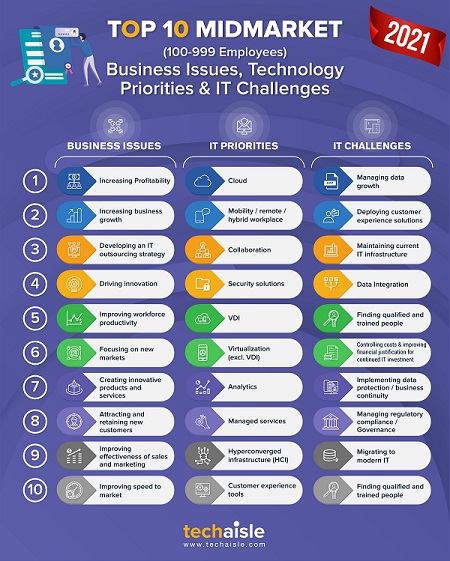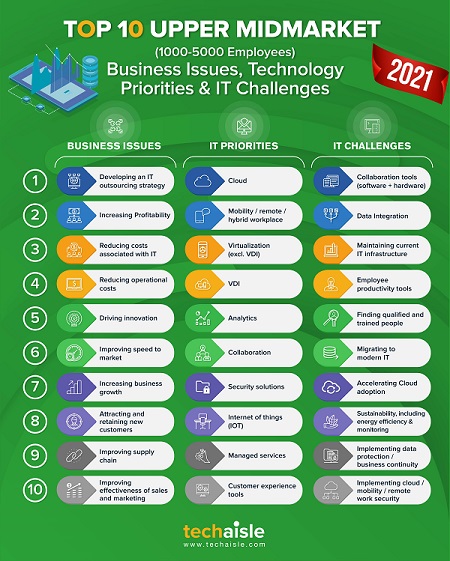Survival of every business depends upon customers, and 2020 saw a ground-breaking year when customer intimacy (acquisition, retention, experience & satisfaction) drove technology adoption and business process evolution within the SMB and midmarket segments. Businesses in general, and SMBs in particular, have many poorly automated or un-automated tasks and processes that they could meaningfully improve by using focused SaaS applications. 59% of small businesses, 86% of core midmarket firms, and 95% have prioritized customer experience solution deployment. Still, IT staff within 38% of small businesses, 47% of core midmarket firms, and 55% of upper midmarket firms face challenges in deploying customer experience solutions.
Five9, a cloud contact center software provider, aims to lessen the IT challenge by “reimagining customer experience” through fully customizable solutions that empower customer agents to address customer needs. Deploying customer intimacy is a little bit like making Baked Alaska: the promise is delicious, but the method is mysterious. The journey from IT systems to a better customer experience isn’t a matter of magical alchemy that wreathes unlikely ingredients with an alluring halo. Instead, it results from a roadmap that starts with digitizing data and processes, moves forward through connected systems that encourage and support fact-based customer-facing activity, and result in an organizational capacity to understand and respond to customer needs. Midmarket businesses understand the appeal of the outcome – and they need guidance from suppliers like Five9 that can define the recipe for customer experience.
Five9 knows that contact center software is only one component of a set of sales, marketing, and customer service solutions. It knows that, with customer experience, it’s the mystery of how to aggregate data and integrate it with customer-facing activities successfully. Recent global SMB and midmarket research from Techaisle shows that within US small businesses, customer-focused SaaS business application adoption increased by 49% in 2020 and will rise by another 33% in 2021. Techaisle data shows that by the end of 2021, 76% of new SaaS adoption within SMBs will be customer-focused. Similarly, within the US midmarket firms, the adoption reached 82% in 2020, with 74% planning to add adjacent customer-focused applications in 2021. Europe research shows similar trends. To deliver on the promise of “reimagining customer experience,” extending the functionality of its solutions, and automating entire customer-facing business processes, Five9’s software must integrate with CRM, online retail, automated quoting, eCommerce, social chatbots, email, forms management, help desk, and queue management.
Integration is a crucial impediment to customer experience. Executives often see examples of organizations using data drawn from integrated internal systems, or from social media, from far-flung sensors, or third-party services, or from a mix of all of these sources – to improve the critical operating parameters of their businesses. However, these answers aren’t simply a result of having technology within an organization. Instead, better customer experience results from linking technology (and the data it collects, shares, and enhances) with front-line functions, which requires understanding how to develop technical competencies and integrate them within the organization.
Five9 has identified several partner types, especially CRM solution providers, UC suppliers, and ISVs, to deliver an integrated customer experience solution. Five9 has built an adapter to enable clients of all sizes to seamlessly integrate its CTI with CRM solutions such as Kustomer, Microsoft Dynamics, NetSuite CRM, Oracle, Salesforce, ServiceNow, and Zendesk.
For the CRM solutions providers, Five9 follows three distinct engagement models, each of which can establish Five9 and its partners as a partner of the customer, invested in their business success. At the same time, if executed correctly, the models enhance the revenue stream of Five9 and its partners.
• Sell into the customers who are already using CRM solutions from one of the Five9 integration partners
• CRM solution providers get introduced to the Five9 installed base to help with total CX transformation
• Joint selling into new customer accounts who are evaluating CRM and contact center solutions
The above is not a simple, straightforward set of changes to embrace. However, the changes are central to transitioning to where the opportunity is growing – and this, more than any adherence to tried and true practices, is the goal to position its businesses for long-term viability. The nature of the partner relationship is a critical determinant of Five9 success. From a strategic sales enablement perspective, Five9 is focused on alignment with its sales team to create a better system by educating its sales team on the benefits of selling together with its CRM partners.
Unified communications is another technology area where most SMBs and midmarket firms have high planned adoption rates. However, the inhibitor is the inability of a hosted solution to adequately meet the needs of an SMB organization which demands many feature sets - call hand-off, integration with CRM solutions, integration of vertical applications, group calling/directory, and regulatory compliance. To enable such features necessitates customization or integration expenses which wipes out the cost savings. Five9 has partnered with Nextiva, Microsoft Teams, fuze, Zoom, TetraVX, and Mitel to integrate contact center and back-office, which augments the telephony and conferencing solutions to enable agents to be more efficient in solving a customer problem. Since many UC suppliers work with resellers as well, Five9 has aligned its partner program to understand how to build complementary routes to market options to capture as much market share together as possible.
ISVs are essential to cloud suppliers serving all types of customers. For example, cloud vendors, such as Five9, looking to build an enterprise-level platform need ISVs to provide critical capabilities to the core offering. In addition, vendors attempting to penetrate target markets work with a specific application vendor to demonstrate the relevance of their services; the ISV, in turn, relies on the platform vendor to provide evidence of a trustworthy application delivery platform. And cloud solution suppliers may position cloud applications as an extension of their core relationship with a customer, even as the ISV involved views them as a resale channel with excellent access to a high-value target buyer community.
Five9 has a formal ISV partner program with co-sell agreements, provides development support and accreditation, and promotes ISV solutions via Five9 CX Marketplace. Five9 already has 70+ ISVs in its program. These ISVs get access to the development environment, documentation, APIs, and SDKs to build integrations. Once the ISVs have built their integrations, they get accredited, and solutions get listed on Five9’s marketplace. To drive success, Five9 has a two-way referral initiative along with a co-sell motion. As a result, the program is growing every quarter, with an increasing number of partners wanting to partner with Five9.
Five9 is anchoring its global partner program on white-glove service, empowering partners, certifications, and development support. This year, Five9 is moving to target the right partners and provide new and improved professional certification options. It is also focusing on specific routes to market around certifications. In Five9’s own words, “…our special sauce is aligning with the Five9 sales team, demonstrating value, building mutual interest and trust, through initiatives such internal newsletter.” Partner Loop, a monthly newsletter, keeps all of Five9’s salespeople in the loop on sales wins, resources, all the great things happening with the partners, and why they should continue to win together with the partners. In addition, to accelerate time to market for its sales teams, Five9 has a partner locator, partner profiles, and CRM and UC integration guides to reduce the complexity of sales conversations. Partner Hello is an onboarding and activation concept that is seeing tremendous success and driving engagement. Five9’s amplify education webinar series provides training to its partners on new services and products. Five9 is addressing essential partner requirements. Techaisle partner survey shows that onboarding training and webinars are the two most crucial training options for partners with certification programs and web training modules representing the next-most important training options
To top it all, Five9 has also launched its Five 9 Global Partner Advisory Board and new Five9 Partner Hello Onboard and Welcome Guide in June.
Modern IT generally delivers systems that improve sales process efficiency and visibility. The drive to develop new customers and retain existing ones directly impacts the desire to emphasize solutions that support business growth, including social media, mobility, and analytics. Additionally, growing business confidence affects all business-relevant solution areas, freeing up resources for new solution exploration, adoption, and optimizing or redesigning business processes. Besides pure SaaS business applications, including cloud solutions, analytics, marketing automation, customer service, CRM, and other adjacent solutions, data shows that SMBs are planning to increase spending in AI, Chatbots, voice assistants, UCaaS, and mobility solutions.
Five9 is positioning itself to be a key player in the customer experience solution segment by successfully embracing an industry-wide trend away from rigid solution definition towards fluid, flexible configurations that integrate multiple components and moving from opportunistic to strategic. In addition, it is accelerating collaboration across partners for predictable, rapid responses to customer demands, becoming proactive in building effective relationships with trusted allies.


















